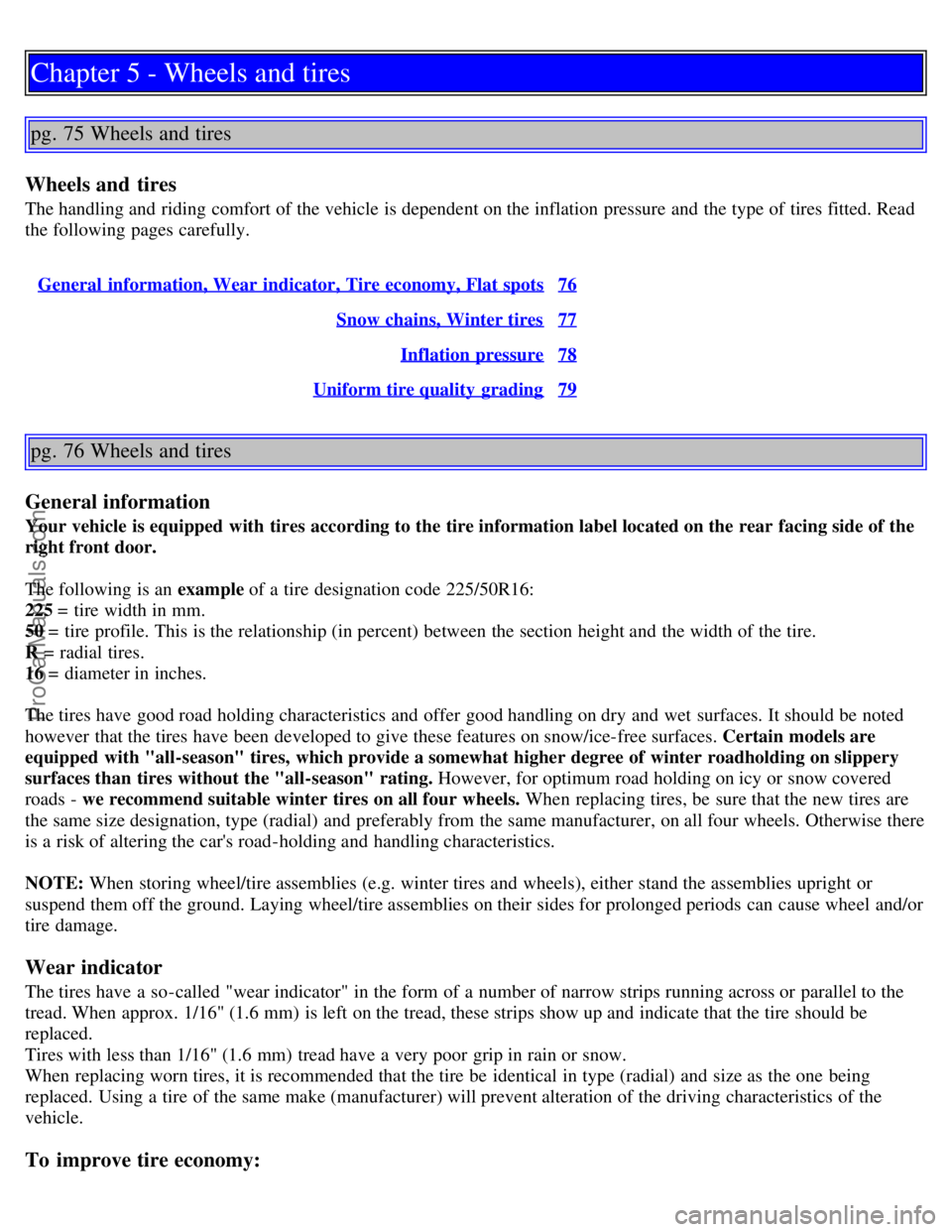run flat VOLVO C70 1998 Owners Manual
[x] Cancel search | Manufacturer: VOLVO, Model Year: 1998, Model line: C70, Model: VOLVO C70 1998Pages: 38, PDF Size: 0.71 MB
Page 18 of 38

Chapter 5 - Wheels and tires
pg. 75 Wheels and tires
Wheels and tires
The handling and riding comfort of the vehicle is dependent on the inflation pressure and the type of tires fitted. Read
the following pages carefully.
General information, Wear indicator, Tire economy, Flat spots
76
Snow chains, Winter tires77
Inflation pressure78
Uniform tire quality grading79
pg. 76 Wheels and tires
General information
Your vehicle is equipped with tires according to the tire information label located on the rear facing side of the
right front door.
The following is an example of a tire designation code 225/50R16:
225 = tire width in mm.
50 = tire profile. This is the relationship (in percent) between the section height and the width of the tire.
R = radial tires.
16 = diameter in inches.
The tires have good road holding characteristics and offer good handling on dry and wet surfaces. It should be noted
however that the tires have been developed to give these features on snow/ice-free surfaces. Certain models are
equipped with "all-season" tires, which provide a somewhat higher degree of winter roadholding on slippery
surfaces than tires without the "all-season" rating. However, for optimum road holding on icy or snow covered
roads - we recommend suitable winter tires on all four wheels. When replacing tires, be sure that the new tires are
the same size designation, type (radial) and preferably from the same manufacturer, on all four wheels. Otherwise there
is a risk of altering the car's road-holding and handling characteristics.
NOTE: When storing wheel/tire assemblies (e.g. winter tires and wheels), either stand the assemblies upright or
suspend them off the ground. Laying wheel/tire assemblies on their sides for prolonged periods can cause wheel and/or
tire damage.
Wear indicator
The tires have a so-called "wear indicator" in the form of a number of narrow strips running across or parallel to the
tread. When approx. 1/16" (1.6 mm) is left on the tread, these strips show up and indicate that the tire should be
replaced.
Tires with less than 1/16" (1.6 mm) tread have a very poor grip in rain or snow.
When replacing worn tires, it is recommended that the tire be identical in type (radial) and size as the one being
replaced. Using a tire of the same make (manufacturer) will prevent alteration of the driving characteristics of the
vehicle.
To improve tire economy:
ProCarManuals.com
Page 20 of 38

different design as this could also negatively affect overall tire road grip. Volvo recommends 195/65 R15 winter tires
on 15" steel wheels on all C70 models including those equipped with 16", 17" or 18" wheels.
Winter tires wear more quickly on dry roads in warm weather. They should be removed when the winter driving
season has ended.
Studded tires should be run-in 300-600 miles (500-1000 km) during which the car should be driven as smoothly as
possible to give the studs the opportunity to seat properly in the tires. The car tires should have the same rotational
direction throughout their entire lifetime. In other words, if you wish to rotate the wheels, make sure that the same
wheels are always on the same side of the car.
NOTE: Please consult state or local regulations restricting the use of studded winter tires before installing such tires.
* Where permitted
pg. 78 Wheels and tires (cont.)
Checking and correcting tire pressure
Check the tire pressure when refueling.
The tire pressure should be corrected only when the tires are cold.
With warm tires, correct only when the pressure is too low. The tire temperature rises after driving just a few miles.
Vehicle Loading
The tires on your Volvo will perform to specifications at all normal loads when inflated as recommended on the tire
information label* located on the rear facing edge of the passenger's door. This label lists both the tire and vehicle
design limits.
Do not load your car beyond the load limits indicated.
* Please note that the tire information label indicates pressures for both comfort and fuel economy.
Tire pressure label
pg. 79 Wheels and tires (cont.)
Uniform tire quality grading
ALL PASSENGER CAR TIRES MUST CONFORM TO FEDERAL SAFETY REQUIREMENTS IN
ADDITION TO THESE GRADES
TREADWEAR
The treadwear grade is a comparative rating based on the wear rate of the tire when tested under controlled conditions
on a specified government test course. For example, a tire graded at 150 would wear one and one half (1 1/2) times as
ProCarManuals.com